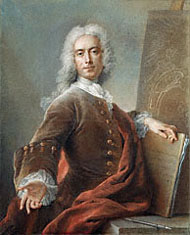 |
 |
 |
 |
Grades/Level: Lower Elementary (K–2)
Subjects: Visual Arts
Time Required: 2–Part Lesson
One to two class periods
Author: J. Paul Getty Museum Education Staff
Permissions: 
The lesson plan and downloadable materials on this page are licensed under a Creative Commons Attribution 4.0 International License. |
 |
|
 |
 |
 |
 |
 |
 |
 |
Lesson Overview |
 |
Students will examine Charles-Antoine Coypel's Self-Portrait and understand what he shows in this work. |
 |
 |
 |
 |
 |
Learning Objectives |
 |
Students should be able to:
• learn about self-portraits.
• discuss and analyze a self-portrait and decide what the artist is trying to tell us about himself.
• create their own self-portraits using props that say something about themselves. |
 |
 |
 |
 |
 |
 |
 |
 |
 |
Materials |
 |
• Reproduction of Self-Portrait by Charles-Antoine Coypel
• Drawing paper or construction paper
• Pastels
• Pencils |
 |
 |
 |
 |
 |
|
|
 |
 |
 |
 |
 |
Lesson Steps |
 |
1. Begin by using the Questions for Teaching for Self-Portrait by Charles-Antoine Coypel. Both are found in the Image Bank, or by clicking on the thumbnail of the image above.
2. Explain to students what a pastel is: a chalk of dry pigment mixed with just enough binder to hold it together. The word also applies to the work of art itself. Because the colors remain on the surface in a powdery form, pastel paintings are extremely fragile. Pass around pastels and discuss with the students how pastels differ from paint.
3. Coypel included props in his self-portrait that tell about his job as an artist. Discuss with students what props they would want to include in their own self-portraits that would tell something about themselves. Talk about their interests, hobbies, sports, etc.
4. Explain to students that they are going to create their own self-portraits using pastels. They should fill the page with their drawings and include at least two objects that tell something about themselves.
5. Model for students how to begin their portrait with an oval for the face. You may want to show them how to set their portraits on the page, encouraging them to fill the entire sheet of paper.
6. Use mirrors for the students to examine themselves and draw from. They can include the clothes that they are wearing when they make their portrait, or they could choose to use a favorite piece of clothing.
7. After they are finished, bring them together and talk about the self-portraits as a class. What has each person tried to communicate about himself or herself and about his or her individual interests? Discuss what the other students see in the individual portraits that they created. |
 |
 |
 |
| Self-Portrait, Charles-Antoine Coypel, 1734
|
 |
|
 |
 |
 |
 |
 |
 |
 |
Assessment |
 |
Students will be assessed based on their completion of the project and their inclusion in their portraits of at least two props that communicate something about themselves. |
 |
 |
 |
 |
 |
Extensions |
 |
Look at other self-portraits from the Getty collection, portraits that show character, different expressions, or actions. For example, examine Self-Portrait, Yawning by Joseph Ducreux or Self-Portrait by Edgar Degas. Talk about the action he is showing in his portrait. Ask the students to create a portrait of an action like yawning. Students could also create self-portraits that show different moods. |
 |
 |
 |
 |
 |
 |
 |
 |
 |
Standards Addressed |
 |
Common Core Standards for English Language Arts
Grades K–2
SPEAKING AND LISTENING
K.1 Participate in collaborative conversations with diverse partners about kindergarten topics and text with peers and adults in small and larger groups.
K.4 Describe familiar people places, things, and events, with prompting and support, provide additional detail.
1.1 Participate in collaborative conversations with diverse partners about grade 1 topics and text with peers and adults in small and larger groups.
1.4 Describe familiar people places, things, and events, with relative details expressing ideas and feelings more clearly.
2.3 Ask and answer questions about what a speaker says in order to clarify comprehension, gather information, or deepen understanding of a topic or issue.
2.4 Tell a story or recount an experience with appropriate facts and relevant, descriptive details, speaking audible in coherent sentences.
Visual Arts Content Standards for California Public Schools
2.2 Demonstrate beginning skill in the use of art media, such as oil pastels, watercolors, and tempera.
3.1 Explain how artists use their work to share experiences or communicate ideas.
4.1 Compare ideas expressed through their own works of art with ideas expressed in the work of others.
4.3 Use the vocabulary of art to talk about what they wanted to do in their own works of art and how they succeeded.
|
 |

|
 |
 |
 |


